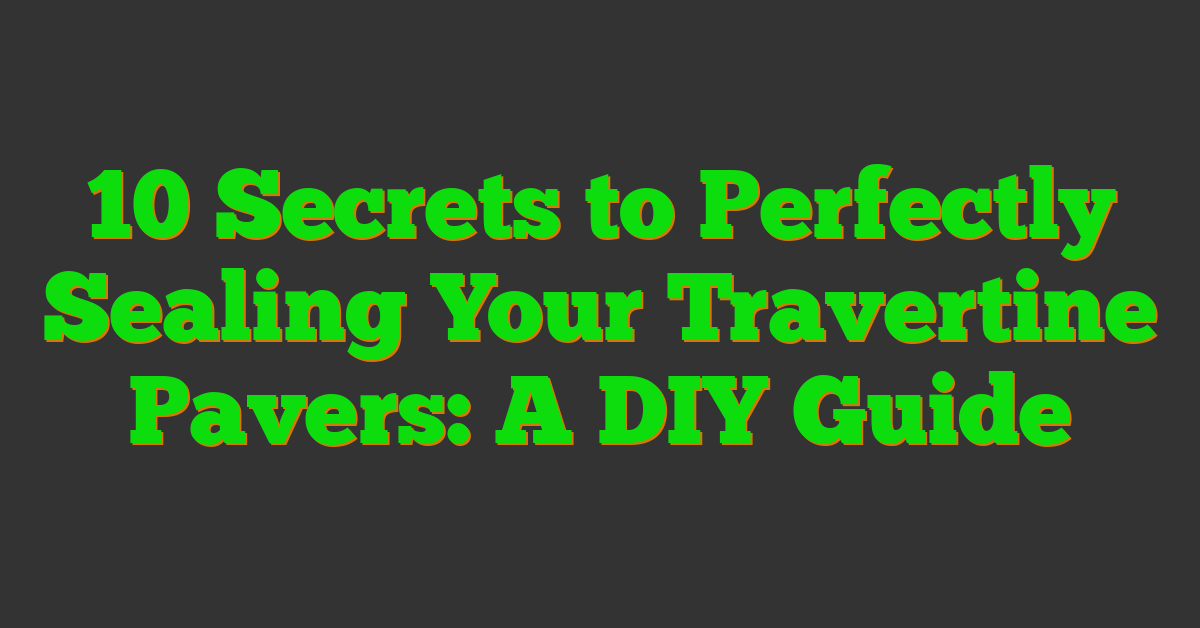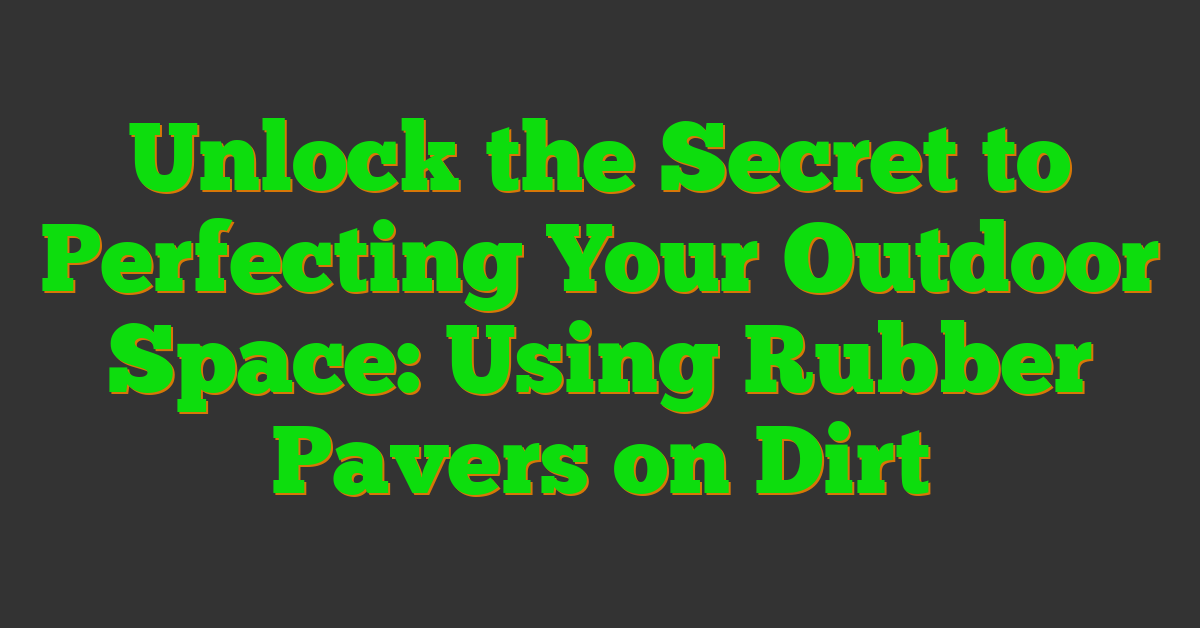When it comes to enhancing the beauty and longevity of your outdoor space, travertine pavers are a popular choice for many homeowners. These natural stone pavers offer a timeless appeal and durability that can transform any patio or walkway into a stunning feature. However, a common question that arises is whether travertine pavers need to be sealed to maintain their appearance and integrity.

In our article, we’ll explore the importance of sealing travertine pavers and the benefits it can bring to your outdoor living area. From protecting against stains and weathering to enhancing the natural colors and textures of the stone, sealing can play a crucial role in preserving the beauty of your paved surfaces. Join us as we delve into the world of travertine pavers and uncover the best practices for keeping them looking their best for years to come.
What Are Travertine Pavers?
Understanding Travertine as a Material
Travertine is a versatile and popular material that we, as landscape designers, often recommend for outdoor projects. It is a type of limestone that forms around mineral spring deposits, giving it a unique, natural look. Travertine pavers are known for their durability, making them ideal for various outdoor applications. Their natural pores and textures add character to outdoor spaces, blending seamlessly with the environment.
Common Uses of Travertine in Outdoor Spaces
In our experience, we have used travertine pavers in a multitude of outdoor settings to create stunning and functional designs. From patio areas and pool surrounds to walkways and outdoor kitchen flooring, travertine pavers offer a sophisticated touch to any outdoor space. Their ability to withstand the elements while maintaining their aesthetic appeal makes them a popular choice for both residential and commercial landscaping projects.
The Debate: To Seal or Not to Seal Travertine Pavers
Benefits of Sealing Travertine Pavers
When it comes to travertine pavers, our experience as landscape designers has shown that sealing them can offer several significant benefits. Firstly, sealing helps in safeguarding the pavers against stains caused by spills or natural elements like leaves or bird droppings. This protective layer not only prevents discoloration but also simplifies the cleaning process. Additionally, sealing can enhance the colors and textures of travertine, emphasizing their natural beauty. This preservation ensures that the pavers maintain their aesthetic appeal for a longer time, even when exposed to varying weather conditions.
Arguments Against Sealing
On the other hand, some may argue against sealing travertine pavers, citing concerns about altering the natural look and feel of the stone. While sealing can enhance the colors, textures, and longevity of the pavers, it may also give them a slightly different appearance than untreated stone. Some prefer the weathered, aged look that unsealed travertine develops over time. Furthermore, there are maintenance considerations to keep in mind when sealing travertine. Periodic resealing is necessary to maintain the protective layer, adding to the overall upkeep of the outdoor space. Ultimately, the decision to seal or not to seal travertine pavers depends on individual preferences, aesthetic goals, and maintenance capabilities.
Types of Sealants for Travertine Pavers
As landscape designers, we understand the significance of choosing the right sealant for travertine pavers to ensure their longevity and beauty in outdoor projects. When it comes to sealants for travertine pavers, there are two primary types to consider: penetrating sealants and surface sealants. Let’s delve into the details of each to help you make an informed decision for your outdoor space.
Penetrating Sealants
Penetrating sealants are designed to be absorbed into the porous structure of the travertine pavers, providing protection from within. These sealants are ideal for safeguarding the pavers against moisture, oil, and other contaminants that can cause damage over time. By penetrating below the surface, these sealants help to maintain the natural look of the travertine while offering excellent protection.
Surface Sealants
On the other hand, surface sealants create a protective layer on the top of the travertine pavers, acting as a barrier against stains and weathering. Surface sealants are relatively easier to apply and can enhance the color and texture of the pavers, giving them a subtle shine. However, it’s essential to note that surface sealants may alter the appearance of the pavers slightly, especially by adding a sheen to the surface.
When deciding between penetrating and surface sealants for your travertine pavers, consider factors such as the level of protection required, desired maintenance routine, and the aesthetic goals for your outdoor space. Consulting with a professional landscape designer can also help you choose the best sealant based on your specific needs and preferences.
Sealing Travertine Pavers: A Step-by-Step Guide
Choosing the Right Sealant
When it comes to selecting the ideal sealant for travertine pavers, our goal is to balance protection with aesthetics. For those looking to preserve the natural look of the pavers while ensuring they are adequately protected, we recommend opting for penetrating sealants. These sealants work from within the stone, offering excellent protection against moisture and stains without altering the appearance. On the other hand, surface sealants provide a protective layer on top of the pavers, enhancing their color and adding a subtle sheen. However, it’s essential to note that surface sealants may slightly change the look of the pavers, so choose according to your desired outcome.
Preparing the Travertine Surface
Before applying any sealant, it’s crucial to prepare the travertine surface properly. Start by cleaning the pavers thoroughly to remove any dirt, debris, or previous sealant residues. A mixture of mild detergent and water can help in this process. Once the pavers are clean, allow them to dry completely before proceeding with the sealing. Inspect the surface for any damage or areas that may need repairs, as sealing can sometimes lock in imperfections. Address any issues before moving forward to ensure a flawless finish.
Application of the Sealant
When it’s time to apply the sealant, make sure to follow the manufacturer’s instructions carefully. Use a high-quality sealant applicator or a paint roller to achieve an even coat across the travertine surface. Work in small sections to ensure thorough coverage and avoid leaving streaks or uneven patches. Once the sealant is applied, allow it to dry completely as per the recommended drying time. For optimal results, consider applying multiple coats of sealant, allowing each layer to dry before adding the next. This will provide additional protection and enhance the durability of your travertine pavers.
Maintenance of Sealed Travertine Pavers
As landscape designers, we understand the importance of maintaining sealed travertine pavers to ensure their longevity and visual appeal. Proper maintenance plays a crucial role in preserving the beauty and functionality of outdoor spaces. Let’s delve into some essential tips for caring for sealed travertine pavers effectively.
Cleaning and Care Tips
When it comes to preserving the look and integrity of sealed travertine pavers, regular cleaning is key. We recommend using a mild detergent or a stone-specific cleaner diluted in water to gently clean the surface. Avoid harsh chemicals that can damage the sealant and the stone itself.
To maintain the pavers’ pristine condition, we suggest sweeping or using a leaf blower regularly to remove debris and dirt that could potentially scratch the surface. Additionally, promptly address any spills to prevent staining and maintain the pavers’ appearance.
For stubborn stains or built-up grime, consider gentle scrubbing with a soft-bristled brush or sponge. Always rinse the pavers thoroughly with clean water after cleaning to remove any residue and ensure a spotless finish.
When to Reapply Sealant
Sealed travertine pavers require periodic resealing to maintain their protective barrier and aesthetic appeal. The frequency of reapplication depends on various factors such as the type of sealant used, the pavers’ exposure to elements, and the level of foot traffic they endure.
As a general guideline, we recommend checking the condition of the sealant annually. Conduct a simple water test by sprinkling water on the surface. If the water beads up and does not absorb into the stone, the sealant is still effective. However, if the water seeps into the pavers, it’s time to reseal them.
« Why Do Pavers Turn White? Learn the Surprising Truth Behind This Common Outdoor Dilemma 🔥 Revealed: The Ultimate Guide to Keeping Your Feet Cool on Porcelain Pavers in the Blistering Sun! ☀️ »
In high-traffic areas or regions with extreme weather conditions, more frequent resealing may be necessary to maintain optimal protection. Be proactive in monitoring the pavers’ condition to prevent damage and ensure they retain their beauty for years to come.
By following these cleaning and maintenance tips, you can prolong the life and enhance the appearance of your sealed travertine pavers, creating a stunning outdoor space that’s both functional and visually appealing.
Conclusion
Sealing your travertine pavers is essential for maintaining their beauty and longevity. By choosing the right sealant and following proper sealing techniques, we can protect our outdoor spaces effectively. Regular maintenance, including cleaning and resealing as needed, will ensure that our travertine pavers remain in top condition for years to come. Remember, a little effort goes a long way in preserving the charm and durability of your outdoor area. So, let’s seal those pavers and enjoy a stunning outdoor space that’s both inviting and durable!
















